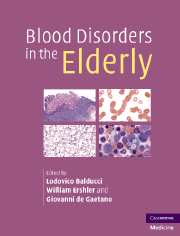Book contents
- Frontmatter
- Contents
- List of contributors
- Preface
- Part I Epidemiology
- Part II Hematopoiesis
- Part III Anemia of aging
- 12 Erythropoietin and aging
- 13 Iron and aging
- 14 Prevalence and mechanisms of B12 deficiency
- 15 Consequences of chronic anemia in the older person
- 16 The pathogenesis of late-life anemia
- 17 Treatment of late-life anemia
- Part IV Hematologic malignancies and aging
- Part V Disorders of hemostasis in the elderly
- Index
17 - Treatment of late-life anemia
from Part III - Anemia of aging
Published online by Cambridge University Press: 21 October 2009
- Frontmatter
- Contents
- List of contributors
- Preface
- Part I Epidemiology
- Part II Hematopoiesis
- Part III Anemia of aging
- 12 Erythropoietin and aging
- 13 Iron and aging
- 14 Prevalence and mechanisms of B12 deficiency
- 15 Consequences of chronic anemia in the older person
- 16 The pathogenesis of late-life anemia
- 17 Treatment of late-life anemia
- Part IV Hematologic malignancies and aging
- Part V Disorders of hemostasis in the elderly
- Index
Summary
Anemia in geriatric populations
Common among goals in geriatric medicine is to preserve functional independence and active life. In so doing, it becomes important to recognize and manage conditions that precipitate functional dependence and aggravate coexisting disease. Recent research has identified anemia as one of these contributory conditions, as its presence alone has been associated with diminished physical and cognitive function, greater likelihood of falling, aggravated comorbidities, and decreased survival. Thus the presence of anemia has become a target of clinical investigation in geriatric medicine.
In general, older community-dwelling individuals appreciate autonomy and have significant negative concerns regarding nursing-home placement. Yet with functional decline, especially if this includes an impairment of one or more of the basic activities of daily living (ADL: bathing, dressing, feeding, transferring, toileting, continence), nursing-home placement becomes increasingly common. For example, rates of nursing-home placement for older individuals with one impaired ADL have ranged from 20% to 70% depending on circumstances, such as caregiver availability, economic factors, and whether or not the impairment was acute or chronic. Although not studied in the context of ADLs or nursing-home placement, it is likely that the presence of anemia is a contributing factor to the rate of institutionalization.
- Type
- Chapter
- Information
- Blood Disorders in the Elderly , pp. 214 - 222Publisher: Cambridge University PressPrint publication year: 2007



